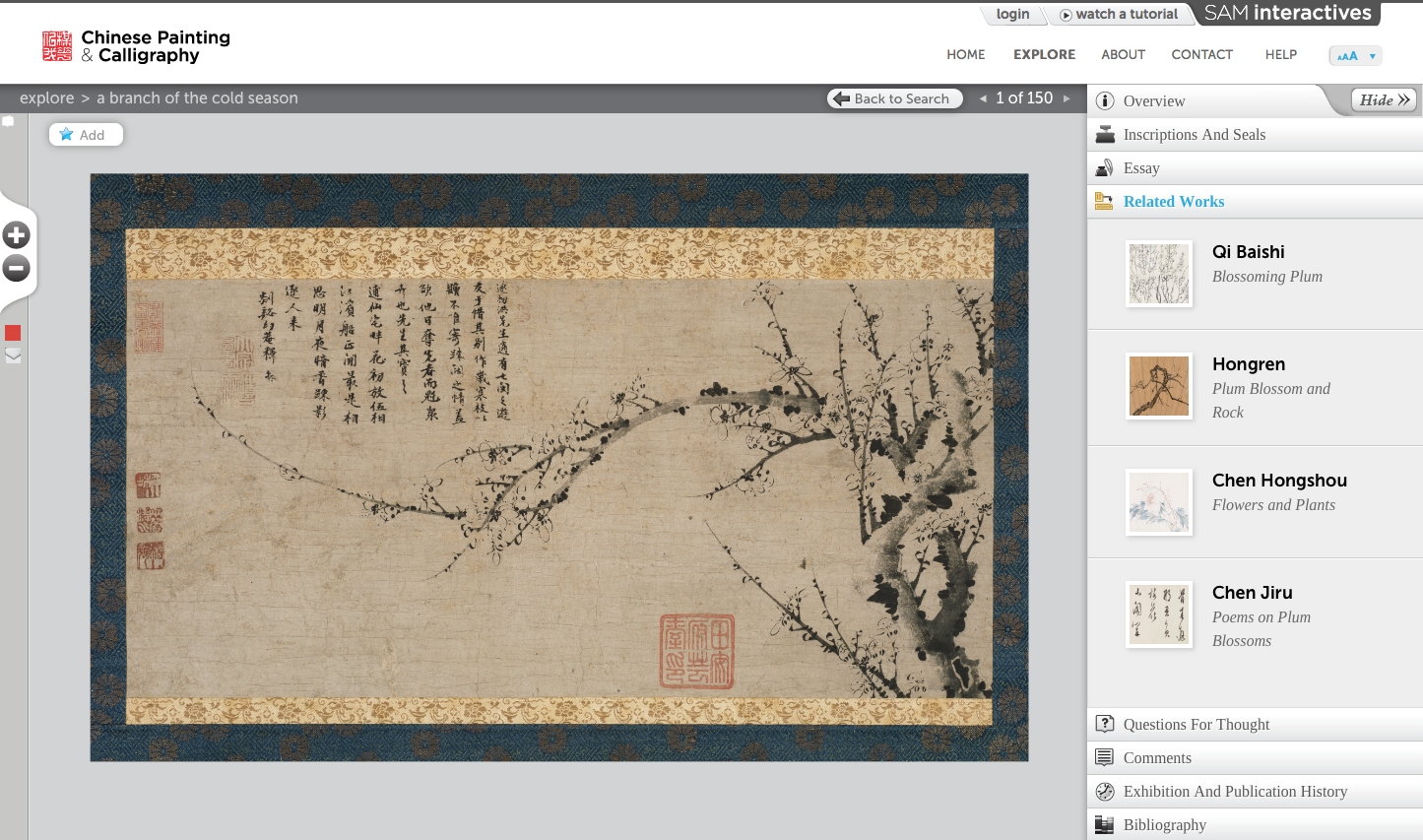Searching and accessibility
This last question is a matter essentially of that seemingly most prosaic component of digital life, the search function. From the Internet to the library catalog to our own file systems, searching for things is a ubiquitous operation, one that helps us navigate nearly infinite data pools (the Internet), as well as engage efficiently with more modest quantities of information (our hard drives). Data do not have to be “big” to be larger than we can effectively sort in our minds; the SAM collection consists of only 150 objects, yet the addition of inscriptions, seals, mountings, genres, styles, and numerous other pieces of data for each work quickly causes details to mushroom beyond our ready grasp. While the right-hand catalog sidebar usefully shows a list of "♦related works” in the collection, the bases for these linkages are not clearly explained; they appear to be derived from the categories by which one can filter the collection through the search sidebar on the left, such as genre, format, and date, among others. But what if you found a seal of particular interest and wondered whether it appeared on any other paintings in the SAM collection? What if it were possible to search for that seal not just within SAM’s holdings but also in collections around the world?

These questions, and others raised above, are asked not to identify shortcomings in the SAM catalog but rather as thoughts on directions for future efforts. How can we make object-based interfaces more “generous,” such that both the search function and the interface itself facilitate the formation of open-ended questions, new connections, and unexpected discoveries?[9] Although SAM’s platform incorporates a rich variety of ways to engage with individual objects, the objects themselves remain relatively siloed. By contrast, the National Gallery of Australia’s Australian Prints + Printmaking catalog facilitates creative exploration across the collection through color, subject matter, social networks, and other values [10], while the Cooper Hewitt’s Pen permits users to search by drawn pattern, among other options. Regardless of whether these would be the features of most interest to users of SAM’s publication, they suggest possibilities for more generous modes of data access.
Similarly, the richness of data gathered for each of the works in SAM’s Groups 1 and 2 immediately prompts reflection on the potential for cross-institutional searching. As a practical matter, this is a highly complicated proposition: examples of current efforts reflect the work either of close-knit consortia, such as the Dutch Nationaal Museum van Wereldculturen [11], which merges the collections databases of the Tropenmuseum, Museum Volkenkunde, and Afrika Museum, or of an individual researcher, such as Yin Ker’s site examining Aung Soe's illustrations or Adrian Vickers’s Virtual Museum of Balinese Paintings [12]. Getting a grasp on the body of extant material that represents Chinese painting and calligraphy is a monumental task, one complicated by the fact that collections are spread across the globe, storage access is often difficult, if not impossible, and conservation concerns lead many of even the best-intentioned institutions to sharply limit what they will show researchers. Yet printed union catalogs of Chinese painting, whether in China or globally, are well-established research resources.[13] The prospect of collections being linked digitally—with the Getty’s OSCI toolkit or a similar initiative, potentially leading to collaborative efforts across collections—opens whole new vistas for art historical research in the digital realm.
The SAM catalog is an extraordinary resource for the study of an important, underappreciated public collection of Chinese painting and calligraphy. The museum has designed and built an interface that is not only object-centered but also sympathetic to many of the material, perceptual, and embodied realities of looking at these works of art. Chinese Painting & Calligraphy’s approach to cataloging and delivering research opens multiple points and levels of access for a range of users, from interested readers to dedicated researchers. Concerns about editing, the inconsistent application of a style guide, and technical problems are not insignificant, however, and seem to reflect insufficiently close editing of content or troubleshooting of the interface. While at times distracting from the exceptional wealth of material and its presentation, these issues are all easily enough corrected as the site is upgraded over time. The innovativeness of the OSCI project’s structure and the fruitful questions it raises about access and interactivity in digital art research are of far greater significance and should serve as inspiration for future efforts.
STEPHEN H. WHITEMAN is lecturer in Asian art at the University of Sydney [Department of Art History, R. C. Mills Building (A26), University of Sydney, NSW 2006, Australia].
Background image:
Yang Hui, A Branch of the Cold Season, ca. 1440 (detail of seal)
Source: Seattle Art Museum
Yang Hui, A Branch of the Cold Season, ca. 1440 (detail of seal)
Source: Seattle Art Museum
